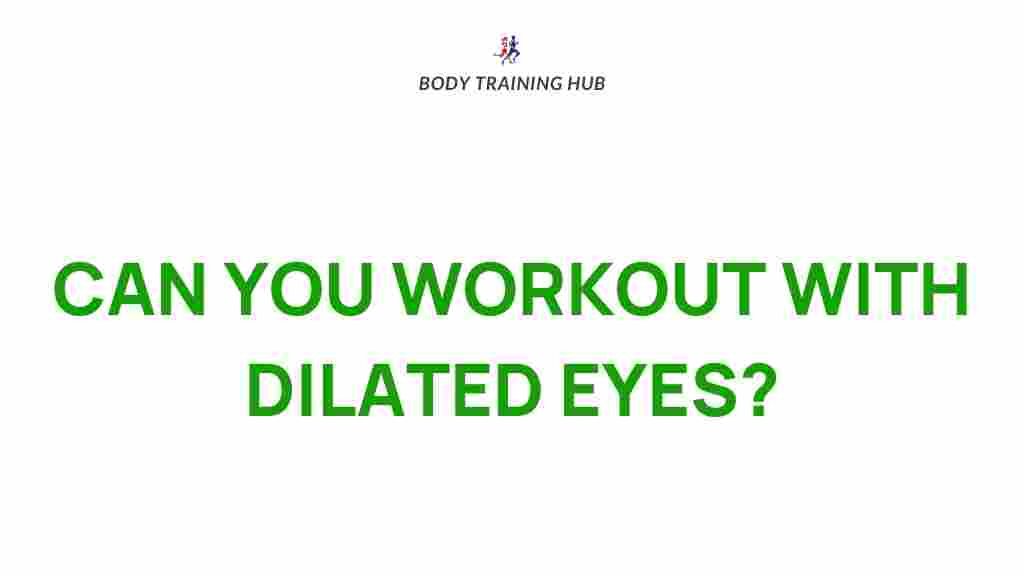Exercising is a cornerstone of a healthy lifestyle. But what happens when you’re faced with an unusual situation, like dilated eyes after a visit to the optometrist? The prospect of hitting the gym or heading out for a run might feel intimidating under such circumstances. This article unpacks everything you need to know about safely engaging in your workout routine after eye dilation.
Can You Still Workout After Having Your Eyes Dilated?
When your eyes are dilated, it means that your pupils have been temporarily enlarged using special drops. While this allows eye doctors to get a closer look at your retina and optic nerve, it also leaves your eyes more sensitive to light and may blur your vision for several hours.
The good news? **You can still workout after eye dilation**, but certain precautions are necessary to ensure safety and comfort. Below, we’ll delve into the key considerations and tips for exercising with dilated eyes.
Understanding Eye Dilation and Its Effects
Eye dilation involves administering drops that relax the muscles in the iris, causing the pupil to open wider than usual. While this is essential for thorough eye examinations, it temporarily alters your visual acuity and light sensitivity.
- Blurred Vision: Tasks requiring fine focus may be difficult.
- Increased Light Sensitivity: Bright environments can feel overwhelming.
- Depth Perception Issues: Judging distances accurately can become challenging.
These side effects can impact your ability to safely perform certain types of exercises, particularly those requiring quick reflexes or precise coordination.
Precautions to Take Before Starting Your Workout
Before you lace up your sneakers, consider these crucial safety tips to protect your eyes and maintain an effective workout:
- Wear Sunglasses: Protect your eyes from bright lights, especially if you plan to exercise outdoors.
- Choose Low-Intensity Activities: Opt for exercises like walking, yoga, or light strength training that don’t rely heavily on vision.
- Avoid Heavy Lifting: Strenuous activities can increase intraocular pressure, which may exacerbate discomfort in dilated eyes.
- Stay Hydrated: Drinking water supports overall health and recovery.
Step-by-Step Guide to Safely Exercising with Dilated Eyes
Follow these steps to ensure your workout is both safe and productive:
- Assess Your Vision: Before starting your workout, take a moment to evaluate how blurred your vision feels. If you’re struggling to see clearly, delay your exercise session.
- Choose the Right Environment: Opt for dimly lit indoor spaces to minimize discomfort caused by light sensitivity.
- Warm Up Gently: Start with a light warm-up to gauge how your body responds while compensating for reduced visual clarity.
- Focus on Stability: Avoid exercises that require rapid movements or balance, as your depth perception might be impaired.
- Listen to Your Body: Pay attention to any discomfort or unusual sensations during the workout. If something feels off, stop and rest.
Common Challenges and Troubleshooting Tips
Even with precautions, you might face challenges during your workout with dilated eyes. Here’s how to address them:
- Overwhelming Brightness: If light sensitivity persists despite wearing sunglasses, switch to indoor workouts or wait until the dilation effects wear off.
- Blurry Vision: For activities requiring visual precision, consider postponing your workout to avoid potential accidents.
- Feeling Lightheaded: If the dilation drops have caused mild dizziness, rest and hydrate before attempting any exercise.
For more tips on eye health and fitness, check out our dedicated eye care resources.
When to Avoid Exercising Altogether
While working out after eye dilation is generally safe, there are circumstances where you should avoid physical activity:
- Severe blurriness or light sensitivity.
- Instructions from your doctor advising rest.
- Experiencing dizziness, nausea, or other unusual symptoms.
If you’re ever in doubt, consult with your healthcare provider before resuming exercise. For further medical guidance, visit Medical News Today.
Conclusion
Exercising with dilated eyes doesn’t have to be a mystery. By understanding the effects of dilation, taking proper precautions, and choosing appropriate workouts, you can stay active without compromising your eye health. Remember to listen to your body and adjust your routine as needed.
For more fitness and health insights, explore our comprehensive fitness guides and keep pushing towards your wellness goals!
This article is in the category Training Guides and created by BodyTraining Team
